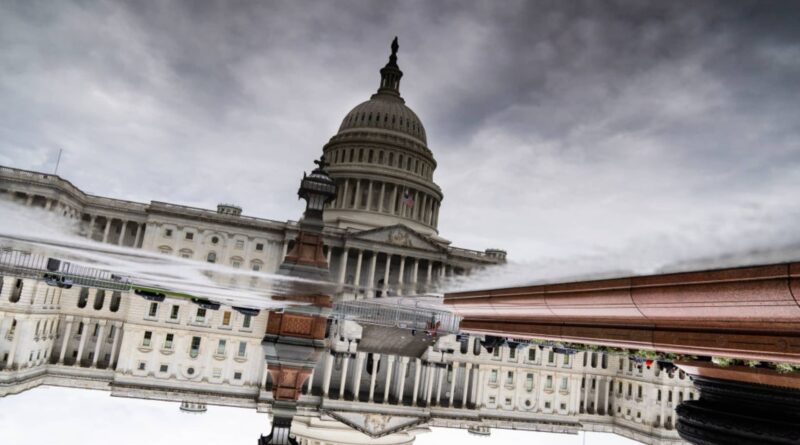Confused about the debt ceiling? Here’s what you need to know
[ad_1]
An inverted image of the U.S. Capitol is reflected in puddle on the East Front on Tuesday, May 9, 2023. (Tom Williams/CQ-Roll Call, Inc via Getty Images)
Tom Williams | Cq-roll Call, Inc. | Getty Images
The White House and Republicans in Congress are mired in a standoff over the debt limit. Failure to raise or suspend it could result in the first-ever U.S. default. Treasury Secretary Janet Yellen has warned that the U.S. could run out of money to pay its obligations as soon as June 1 if Congress doesn’t address the matter.
With neither side looking likely to budge, here’s what you need to know about the situation.
What is the debt ceiling?
It is the maximum amount of money Congress allows the federal government to borrow to cover its bills. Because the government typically spends more money than it collects in taxes, it must take out debt to pay its expenses. Unlike a credit card, though, the expenses were already approved by Congress, so the debt ceiling does not pertain to new spending.
The mechanism was created during World War I in an effort to simplify borrowing. Prior to 1917, Congress needed to approve additional debt for each new spending measure it passed. Until recently, it has been a rather routine process. Congress has lifted the debt limit 78 times since 1960. The debt ceiling was last raised in December 2021 by $2.5 trillion, capping the limit at $31.381 trillion.
If Congress does not agree to lift the debt ceiling, the government will not have money to pay its bills and will default on its debt. The Treasury Department has already begun to take extraordinary measures to continue to fund the government, but Yellen said she expects funding to entirely deplete in early June.
What happens if the U.S. defaults?
Defaulting on sovereign debt would wreak havoc on the economy and roil markets around the world. A default on Treasury bonds could throw the U.S. economy into a tailspin. The last time Congressional Republicans threatened a default in 2011, Standard & Poor’s downgraded the U.S. credit rating for the first time ever to AA+ from AAA.
If the U.S. were to default, gross domestic product would drop 4% and more than 7 million workers would lose their jobs, Moody’s Analytics recently projected. Even a brief default would lead to the loss of 2 million jobs, according to the data.
In that scenario, U.S. bond ratings would be classified as “restricted default,” according to Fitch Ratings, and Treasurys would have a D rating until the U.S. could once again borrow. The Brookings Institution noted a default could lead to $750 billion in higher federal borrowing costs over the next decade.
What’s more, a default would shake the U.S. position on the world stage. U.S. Director of National Intelligence Avril Haines told the Senate Intelligence Committee last week that Russia and China will take advantage of the U.S. potentially defaulting on its debt. Haines warned the two nations would attempt to highlight “the chaos within the United States, that we’re not capable of functioning as a democracy.”
What about government programs?
Were the U.S. to default, it would mean a pause on tens of billions of dollars in payments. The Bipartisan Policy Center estimates in the first half of June, $50 billion in Social Security benefits are set to be dispersed, $20 billion in Medicaid provider payments, $12 billion in veterans’ benefits, $6 billion in federal salaries and $1 billion in SNAP benefits.
In an interview Monday with CNBC, Yellen demurred when asked how payments would be prioritized.
“There are no good options; every option is a bad option,” Yellen said. “I really don’t want to get into discussing them and ranking them because as every Treasury secretary has known, the only option that really leaves our economy and our financial system in good shape is raising the debt ceiling and making clear that Congress stands behind the basic principle that America pays its bills.”
What is the Republican position?
Republicans are concerned about the increasing national debt, which has grown from less than $1 trillion in the 1980s to more than $3 trillion today. They are refusing to lift the debt ceiling unless it is paired with spending cuts.
House Republicans passed the Limit, Save and Grow Act last month outlining the areas they want to pare back. The bill would impose sweeping cuts to federal discretionary spending, impose new work requirements for welfare recipients and expand mining and fossil fuels production, all in exchange for raising the debt limit for about a year.
What is the White House’s position?
The White House has remained steadfast that it is Congress’s responsibility to raise the debt ceiling without conditions, as was done three times under the Trump administration. President Joe Biden has repeatedly called on House Republicans to pass a clean debt ceiling increase and have a separate conversation about spending cuts in the budget.
The president has pleaded with lawmakers to engage in “normal arguments” instead of ultimatums.
“As I’ve said all along, we can debate where to cut, how much to spend, how to finally overhaul the tax system to where everybody has to pay their fair share or continue the route their on, but not under the threat of default,” Biden said Friday. “Let’s remove the threat of default. Let’s have normal arguments. That’s why we have a budget process to debate in the open so you all can see it.”
What’s next?
Leaders from both parties will have to continue discussions in order to reach a compromise before the projected June 1 deadline. If they do not, the Treasury will have to begin making decisions on which bills to prioritize before they run out of money entirely, something Yellen has called untenable.
[ad_2]
Source link



